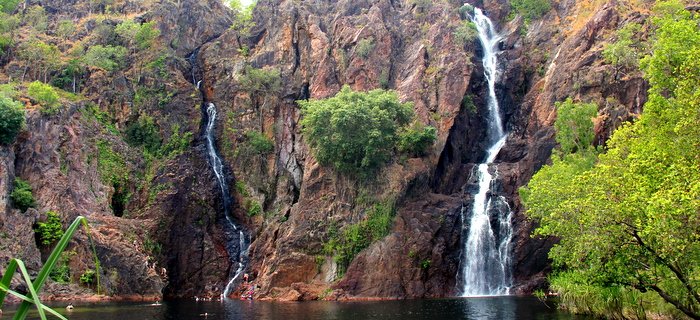Friday, September 16, 2011: Darwin, Autralia
We’ve arrived in the Northern Territory and to Darwin, Australia, the northernmost port on our Australian itinerary, and the gateway to the Australian Outback. Through our travels today won’t take us more than 120kms from Darwin, we will travel down the Stuart Highway, also known as the A1, which runs from Darwin south over 1700kms to Alice Springs in the center of the Outback and continues onto Ayers Rock, a future stop on our itinerary. Our ship pulled up onto the dock just moments after 9am, and though it took 15 or so minutes to put up the gangway and to clear the ship, with the line of anious passengers snaking its way through the Deck 5 Atrium, we had a short wait until we could actually set foot on the ground and begin our day.
A beautiful walk along the Darwin waterfront afforded us the opportunity to see a quiet swimming lagoon and beach, along with a large family wave pool and a craft market on our way into the central business district. Less than a 10 minute wlak into town, we had arrived at the downtown Hertz rental car facility, where we received a free class upgrade and made our way to our silver Ford Focus for the day.
As we made our way out of the city, we wound our way north, east, and then south, as we drove clockwise around the Port Darwin peninsula and finally began to make our way into the interior of the territory. We were definitely in a new place as the scenery and the vehicles changed from the previous lush green rain forest to the clay red dirt most associated with Australian and the Outback as we worked our way through scrub and trees lining the Stuart Highway working our way to the South.
In addition, instead of seeing smaller, fuel efficient vehicles, we were passing by a number of 4×4 range rover type vehicles filled to the brim with tents, supplies, gasoline, and more to handle the harsh realities of the Australian desert. Along with these safari/outback vehicles, we also encountered our first “road trains”. These massive vehicles are simply like a big rig at home, but have between three and four trailers being pulled by a single cab. They are massive in length and really make you think twice about passing them on a two lane highway.
In addition to the desolation that began to take shape about 40kms outside of Darwin, the highway feel from 2 lanes in each direction to one, and the speed limit began to move in the opposite direction. Where we were driving 60-80kph in and around Darwin city, the highway speed limit was increased to 100, and then as we moved further and further away from the population, it went up to 110 and finally to 130kph (78mph). Though drivers were very safe and considerate, even at this speed, it simplies proves that there is very little to get in the way of vehicles travelling on long endless stretches of straight road and they move into the interior of the country.
About an hour into the interior, we made a turn west and about 10 minutes later arrived into the small town of Batchelor, the most significant place we will see all day long, outside of the main city of Darwin and its suburbs. Batchelor is the gateway town to Litchfield National Park, our destination for the day. Though the town actually covered a few kilometers, it didn’t take more than a quick glance for it to pass us by, we arrived at the eastern edge of the park and decided on our course for the day. There is only one road into and out of the park (unless you are a 4×4 vehicle), so we decided to travel as far inland as we could go, which was Wangi Falls at 60kms into the park, and then slowly work our way back out of the park on the same road with stops at Tollmer Falls, Florence Falls, Buley, and the Termite Mounds.
The park itself was a beautiful mix of red (the dirt), browns (tree turnks and vegetation), and greens (leaves of the trees and canopies) as it spread for miles in every direction, split only by the asphalt ribbon of road running through the center. The drive was for the most part uneventful, though increibly scenic and enjoyable. Unfortunately, we lost any radio signals about 20 minutes into the drive and there was no iPod jack in the car, so we just enjoyed the AC as is shot cool air to counterbalance the 90 degree temperatures (and rising) outside in the warm park. As we continued to drive, we began to notice a number of areas recently blacked by fire.
As we continued our drive, we actually began to see some small patches of smoke where branches and some brush were still smoldering. Assuming that a recent storm may have passed through in the previous days with dry lightning strikes, we continued into the park, but began to notice tall columns of white and dark smoke on the horizon. We were headed for the flames, wherever they were in the park…
As we got closer, remaining vigilant and cautious to ensure safe passage to our destination, we began to see signs along the road edge (everything in Australia and New Zealand on the roadways is incredibly well signed — you literally cannot get lost) telling us about upcoming smoke hazards and to turn on our car lights, slow down, and recirculate the air in the car vs. pulling from the outside. The sky grew dark as we continued onto the park and it was evident that we were getting close to whatever the source of all this smoke was. Rounding a corner, there were flames 8-10 feet high on both sides of the roadway as think yellow and brown smoke brough visiblity to near zero. Though at this point we paused for just a moment, we saw two pickups on the side of the road with red flashing lights on them. It was the park rangers, out with canisters of fire starter and they were the ones actually setting the brush on fire!
Evidently as part of the maintenance of the park and to avoid overgrowth for concern of a huge out of control wildfire, they set these backfires all the time to control the brush. A short 1-2km drive later, the skies immediately cleared and we continued into the park with clear blue skies a few high clouds and visibility as far as the eye could see!
The rest of our drive lacked a bit of the fire excitement, but we quickly made our way to Wangi Falls, the innermost stop on Litchfield Park Road. Here, one large waterfall, and a second, smaller fall cascade down beautiful tropical rockfaces into the clear pond below. All around the lagoon there are tall trees and dragonflies of reds and greens buzzing in the air. This location seemed quite popular with folks, though we only shared the falls and the pool below with about 50 people. Nearby, there were picnic tables and BBQ pits for lunches and folks could soak in the cool water or take the 5-10 minute swim across the pool to the falls themselves.
Darin made the trip across and climbed up on the rocks nearest the large fall. As the deafening roar of the water hitting the pond below masked everything else out, you could just look out on the landscape and admire its tropical beauty. Given that the temperature outside was over 90, the cool water provided a much appreciated cooldown and families and many other tourists enjoyed themselves immensely.
We spent almost an hour here as it is the largest of the pools in which to swim and slowly started making our way back towards the entrance to the park. We drove back on the park road for about 10 minutes when we came to the lookout for Tollmer Falls, the second of three that we would be visiting today.
Tollmer Falls is much larger, higher, and more remote than the others, and along with the crocodiles in the vicinity, was not a place to swim at. There was a very nice walkway path that lead to the lookout point and we enjoyed the view, not only of the falls, but of the park and it extended for miles in every direction from the valley floor below our vantage point. Back to the car and to the highlight of our day, Florence Falls.
Though this is the smallest of the three sets of falls and it has a smaller plunge pool, it was not only the most beautiful, but also the least crowded, where the two of us shared it with no more than 5 or 6 people. The falls were not as high up either, so it was actually possible to swim under the cascade, and appreciate the power and intensity of nature in this place. We swam in the crystal clear waters of the plunge pool and under the falls for nearly an hour and then had a short walk back to the car. As we made our way out of the park, we also made a quick stop to see the termite mounds, massive 6 foot high mounds built by native termites in the area, that are precisely made to point north and south along the magnetic poles to ensure proper exposure to the sun for both warmth and cooling regulation of the mound and the colony.
From here, it was back through Batchelor, and onto the main highway to head back North to Darwin and to return the ship. We arrived with about 45 minutes to spare, returned our rental car, and made a few quick stops in the shops nearby for some needed supplies. Then the 10 minute walk back to the Waterfront and to the ship and we were back onboard to continue our sail along to our next port of call… Bali, Indonesia.



Leave a reply